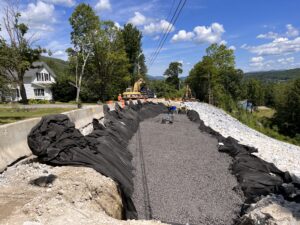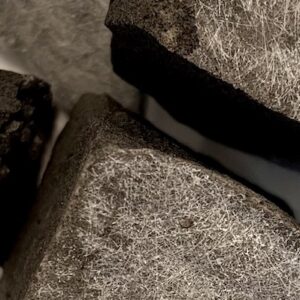
Glavel as a Subslab Insulator
As thermal insulation for subslab insulation systems, foam glass gravel is an environmentally friendly, high performance choice for engineers and architects.
Foam glass can go by a variety of names; foamed glass aggregate, foam glass gravel, or cellular glass. Whatever terminology is used, it’s a lightweight, thermally insulating aggregate made from recycled glass powder. Whether it’s used as lightweight fill in embankments, as thermal insulation underneath a concrete slab, or even as lightweight green roof fill, foam glass is an ideal building material to solve some of the construction industry’s most pervasive issues. Since foam glass aggregate is made entirely from recycled glass, it’s embodied carbon profile is incredibly low (stay tuned for our EPD and LCA in 2024) and is one of the most environmentally sustainable building materials on the market.
The discovery of foam glass was in the early 20th century by a Soviet scientist, but the material did not generate demand until later in the 20th century. High performance buildings and carbon footprint awareness were both catalysts for the increased popularity of foam glass.
Foam glass made in the early 20th century was annealed into blocks and made using non-post consumer glass. It wasn’t until the turn of the century that manufacturers in Europe began using recycled glass and eliminating the annealing process from their operations. Instead, they allowed the thermal stress associated with cooling upon exiting kilns to naturally break up the foam glass slab into aggregate. These shifts simplified the manufacturing process while also increasing the breadth of foam glass applications.
Around the same time that European foam glass manufacturers were shifting to recycled glass inputs, recycling was a burgeoning industry. The surpluses of recycled glass with increased demand for recycled glass cullet for use in foam glass created a market synthesis resulting in a foam glass boom. Manufacturing facilities popped up all over, from Scandinavia, to Germany, Austria, and more. With the use of recycled glass dropping the embodied carbon of foam glass, it quickly became coupled with high performance buildings, whose need for uncompromising performance and material sourcing was a top priority.
Load bearing – 116 psi compressive strength at 10% deformation, post compaction
Frost heave resistant – Will reduce impacts of of freeze and thaw
Produced from recycled glass – Categorized as ‘clean fill’
Water resistant – Closed cell structure facilitates drainage
Non combustible – Will not burn, nor propagate fires
Inert – Prevents rodents, termites, bacteria, and rot
Thermal insulation – R1.7 per compacted inch
Lightweight – 10 pounds per cubic foot
Foam glass aggregate begins as post-consumer recycled glass. Glass of all colors is cleaned to <1% non-glass to eliminate contaminants that may alter the consistency of the finished product. The cleaned glass is milled into a superfine powder, which is measured and mixed with a foaming agent prior to being kiln-fired.
Once the glass powder mixture is prepared, it’s deposited onto a chain link belt, which moves slowly through the kiln at a specific thermal profile to slowly heat the glass to 1,500º. The glass softens as it heats, causing a chemical reaction that foams up the mixture and creates a network of closed cell micropores.
After exiting the kiln, the mixture emerges as a thick foam glass slab. The slab quickly begins breaking and cracking due to thermal stress from the exposure to ambient temperature air. Over the next few minutes of cooling, the aggregate pieces continue to fracture until the particle sizes are 2″-3″ in diameter. At the far end of the cooling table, pieces are discharged onto a conveyor system, where they’re sent to bagging or storage.
As a subslab insulator, foam glass gravel is used as a 2-1 replacement for rigid foam board and crushed stone aggregate. With its compressive strength of 116 psi at 10% deformation, it can be used beneath structural footings as well as on the exterior of a stem wall for additional insulation. At R1.7 per installed inch, Glavel can perform as both insulation and drainage in commercial and residential installations.
Weighing only 10 pounds per cubic foot, foam glass is 90% lighter than traditional gravel aggregate fill. Installing foam glass gravel as fill for a green roof reduces building strain and increases the ability to build creative landscapes. Foam glass can also be compacted at in slopes up to 45°. This gives landscape architects the ability to introduce slope and creativity into designs.
As a lightweight fill, foam glass aggregate can address many of the challenges that the infrastructure world faces today. Whether that is decreasing structural loads, reducing load settlements on soft soils, or stabilizing embankments, foam glass can be a solution to a variety of the civil world’s problems.

As thermal insulation for subslab insulation systems, foam glass gravel is an environmentally friendly, high performance choice for engineers and architects.

Foam glass gravel is used as a lightweight fill solution to some of the construction industry’s most pervasive issues.

Glavel’s first manufacturing facility in Essex VT is live. Learn more about the plant’s features and how it’s unique to the foam glass market.
